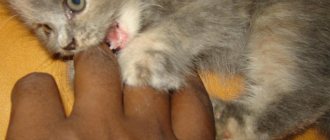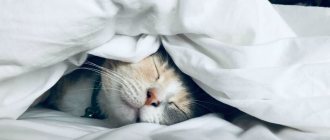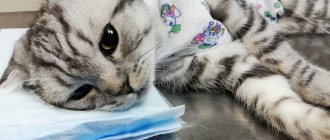The fertility of a pet is an aspect that worries many owners. This is especially true for those whose pet is a representative of a rare and expensive breed. It's no secret that cats are quite fertile by nature and can give birth to hundreds of kittens throughout their lives. However, this figure is approximate. There are many factors that determine the number of babies born at one time. Genetics, living conditions of the animal, nutrition, and physiology of the partner influence.
How many kittens can a cat give birth to?
If we consider averages, then an ordinary cat can give birth to 6-8 babies at a time. However, the number of cubs is not just the will of fate, but a confluence of many factors. There is a case in history when a representative of the Persian breed gave birth to 15 kittens at once. It is also not uncommon for 1-2 babies to be born. So, what will determine the number of future babies?
Features of the female body
How many kittens a cat gives birth to depends, first of all, on the characteristics of her body. The first birth is usually a surprise, and then the owners know roughly what to expect from their pet. What will affect the female's fertility:
- Age
: Primiparas and late-parous women are unlikely to have many babies. Most likely there will be about 1-2 cubs.
- Genetics
: if the cat’s mother was fertile, then the daughter will most likely inherit this quality.
- Size
: a miniature cat, even in its prime, will not bring too many kittens, but a large and well-fed female is capable of regularly giving birth to a large number of babies.
- Health
: if the cat has any problems, then she will bring significantly fewer kittens.
If you know the cat’s mother and this is not the first time you have observed childbirth, then it will not be difficult to determine the approximate number of fetuses even without an ultrasound.
Male fertility
The number of offspring is influenced by the characteristics of your cat's partner. For example, his age: if the cat has not reached 1.5-2 years of age or, conversely, is too old, the quality of his semen will be an order of magnitude lower than that of strong and healthy cats. Pay attention to the frequency of matings of the cat - you should not expect a large litter if he fertilizes more than 4 cats per year.
The father's health is undoubtedly one of the most important factors. Infectious diseases or diseases associated with the reproductive system can affect not only the number and condition of the offspring, but also the health of the mother herself. If you have a purebred cat and are looking for a mating partner, be sure to ask for a health certificate, the necessary documents on purebred, and also ask the owners how many kittens are usually born from a given male.
An amazing feature is characteristic of cats - in one litter there can be fruits from completely different fathers. This is due to the fact that eggs in the body are produced directly during mating. Therefore, outdoor cats produce more kittens than planned breeding pets.
Dependence on breed
Without a doubt, the fertility of a furry mother is also influenced by her breed. Surely you have noticed that ordinary street cats often give birth more than indoor cats? This is due to a simple truth - harsh conditions await children on the street, and the chances of survival are much less than at home. Therefore, to continue the race, a larger number of kittens is needed.
Purebred pets are not so fertile. For example, Scottish women give birth to an average of two or three babies at a time, but British representatives are already capable of bearing 4-5 babies. However, not everyone can master even this breed maximum.
Animals no earlier than 45 days old are allowed to register litters. The breeder selects an appointment day in the visiting schedule and makes an appointment.
The breeder prepares the necessary documents for the registration of a litter of kittens, namely: - An act of mating of breeding animals with copies of the parents' pedigrees and titles, if any, registered in the RSA system. — The act of activating the litter. — Litter distribution data.
The breeder fills out all documents independently, except for the registration number, breed and color index, and sex of the animal.
The breeder assigns nicknames to each kitten. The names of kittens in the cattery are in alphabetical order. The first litter is named with the letter A, the second with the letter B, etc. If there was a release from the litter, for example, in experimental breeding the mother was given a nickname starting with the letter A, then the litter will have the next letter B, etc.
After the kitten's name there is always the name of the nursery (factory prefix). For example, we have the first litter, where the cat was named AMUR, he was born in a nursery that is registered in the RCA system with a name, for example, VESTA. Therefore, the kitten’s full name will be AMUR VESTA.
During a visit to the organization, each kitten is examined by a felinologist and breed curator, its clinical condition and breed data are assessed, the absence of defects or defects is checked, the animal’s sex and preliminary color are determined (the color is finally confirmed in the Open class at on-line cat shows). The felinologist, the curator of the breed, makes entries in the Litter Registration Act and in the Litter Distribution Data, where registration numbers from the animal breeding register, the breed and color index according to the RCA system, and the sex of the animal are assigned.
The breeding cards of the cattery reflect the quality of the litter, the advantages and disadvantages of each kitten. Assessing the quality of breeding stock of animals and their exhibition career is an integral part of the breeding work of a cattery along lines, dynasties and families.
After inspecting the litter, the breeder receives a metric for each standard kitten; this is the initial document on the origin of the animals, on the basis of which the new owner of the animal will be able to register a pedigree for the kitten with the organization.
The breeder does not have the right to transfer a copy of the pedigree of his cat for the release of a litter to another organization or to a new buyer. There is a Secretariat of the organization to receive information.
After completing the litter registration, the breeder can use the services of the advertising department to find clients for kittens. The breeder transfers the completed metric in full, A4 format, to the new owner of the kitten. Without metrics, an animal cannot be considered purebred.
If the cat is pregnant for the first time
Owners often wonder if a cat can give birth to one kitten? If your pet is pregnant for the first time, it is unlikely that her litter will be large. Most likely, 2-3 kittens will be born, or even just one.
The fact is that the cat's reproductive system can only be fully formed after the first pregnancy. A future furry mother can become pregnant as early as 8 months, but this does not mean that such an early pregnancy is desirable. At the age of up to 1 year, her body is so delicate that carrying even one fetus is a risky step. Here it is important to determine not how many kittens a cat gives birth to for the first time, but how she will cope with motherhood and whether her health will be undermined.
Of course, in nature no one keeps track of when cats mate or don’t mate. But at home, a caring owner should not allow early mating at least until 1.5-2 years.
Minimum and maximum
Surely your cat periodically gives birth to 4 to 6 kittens - this is the average for representatives of all breeds. There are also cases of the birth of 8 or more cubs. The fact is that a furry mother has a certain limit - a certain number of babies that she can feed. Their number should not exceed the number of her nipples. If there are more than eight kittens, one will not get milk, which means the baby may die. Then the owners will have to help the young mother feed her offspring.
The minimum number of kittens is one; there are cats that, due to genetic and physiological characteristics, are not able to conceive and bear a large number of fetuses. If your cat usually gives birth to around five babies and suddenly gives birth to one, you should take her to the vet - there is most likely something wrong with her health.
How many kittens can a cat give birth to maximum? It’s hard to say, the known documented limit is 15 pieces. But in general, the number of kittens over 10 is already rare. In purebred animals, the threshold is even lower - they rarely reproduce more than 6 kittens.
An older mother will no longer give birth to the same large litter as in her best years. The reproductive system wears out over time, and the likelihood of a difficult pregnancy increases. It is better to protect your cat from mating after reaching 8-10 years of age.
What determines the number of kittens?
The number of kittens in a litter is influenced by many factors:
- Firstly, this is the age of the cat. Firstborns most often give birth to a maximum of three cubs. Fertility also decreases in fairly mature females. After the age of seven, a cat gives birth to fewer babies than before the age of 6-7 years. The peak of large families (from 4 to 12 babies per litter) occurs between the ages of 3 and 6 years.
- Heredity also affects possible fertility. If the cat's ancestral ancestors produced numerous offspring, then most likely your animal will be fertile.
- The reason for the small number of kittens is often a hormonal imbalance, which leads to a decrease in the synthesis of eggs ready for fertilization.
- Breed also matters. A trend has been noticed: a purebred cat gives birth to fewer kittens than a mongrel yard animal, and rarely gives birth to more than 5 babies at a time.
- Obesity or, conversely, exhaustion reduces the possible number of offspring.
- A lot also depends on nutrition. If a cat does not get enough protein, taurine, vitamins and minerals, she may develop nutritional infertility (infertility). A meager diet leads to the fact that the animal’s defensive reaction to the lack of certain substances is the fertilization of a small number of eggs.
- Chronic inflammatory processes of the reproductive system negatively affect the cat's reproductive function and can cause the cat to become infertile.
- Another reason for the birth of a minimum number of kittens can be long-term and indiscriminate use of hormonal drugs, such as Counter-Sex, Sex-Barrier. Hormone-based contraceptives seriously undermine the reproductive function of the animal, causing hormonal stress in the body. And this, in turn, leads to the birth of a maximum of 1-2 babies in the litter.
The male also contributes to the number of offspring. During sexual intercourse, a temperamental cat releases a larger number of eggs for fertilization. In addition, the quality of sperm also matters.
How to determine the number of kittens in a pregnant cat
If you want to find out how many kittens a cat will give birth to, there are several proven methods:
- Based on genetic data. How many babies did your pet's mother have in her litter on average? Most likely, this factor was inherited from her. If the cat's grandmother had an average of 6 goals at a time, then your pet will have the same number. She is unlikely to give birth to more than her ancestors gave birth to.
- Folk way. Count how many mammary glands the cat has swollen during pregnancy? Then subtract two from their number. Of course, no one can guarantee the effectiveness of such a result, but it is used quite often.
- Scientific method. One of the simplest and most common ways to find out how many kittens a cat will give birth to today is ultrasound. It is done 10-14 days before birth, this will allow you to determine the exact number of fetuses.
Under no circumstances should you try to count the number of fetuses in a pregnant cat by palpating her. This can affect the health of future babies and cause stress for the mother herself. The maximum that can be done is to gently stroke the tummy if the cat exposes it herself.
Keep a close eye on your pet. If she had more than one partner at the beginning of her pregnancy, then she is likely to give birth to both fathers, which means that the number of cubs will be greater than usual.
Duration of pregnancy
A cat's pregnancy lasts on average about 9 weeks. A more accurate period depends on many factors such as age, weight and breed characteristics. For example, owners have found that the process of bearing offspring in short-haired females lasts 58-68 days, in cats with long and medium-length hair it lasts 63-72 days.
How many kittens can a cat give birth to?
The length of pregnancy is also affected by the number of babies inside the womb. The more there are, the earlier the due date will come. Females bearing one to two kittens are able to walk for as long as possible before giving birth. In addition, their health depends on the number of cubs. Statistics show that babies from multiple litters are weaker and sicker.
For your information! In one litter, a female can bring from 2 to 8 kittens, the exact number of which depends on many factors.
How to increase the number of kittens in a litter
This question is most often asked by those owners who are planning to breed and breed a purebred pet. It is important to understand that this is not a simple matter at all, since any mistake can have a detrimental effect on the health of the animal. Be careful not to cause any harm.
The main way to increase fertility, of course, is medications. First of all, you should pay attention to homeopathic remedies. Now in almost every pharmacy you can find at least several products that are not harmful to your pet’s health. Especially notable among them are Gamavit and Ovariovit - these drugs have a beneficial effect on the reproductive system of the expectant mother and help eggs to form in large volumes.
You can contact your veterinarian and consult with him about taking supplements such as selenium and vitamin E. Only a specialist can prescribe exact dosages based on the breed, condition and physiology of the expectant mother. Under no circumstances should you give your cat supplements yourself, otherwise there will be a risk of metabolic disorders and the development of diseases on this basis.
The process of preparing your pet for pregnancy should begin long before mating. If she is already pregnant, there is no point in doing anything.
First aid for a newborn kitten or nursing cat
First aid
1. Dry the kittens if they are damp (with a soft towel or cloth, never a hairdryer)
2. Warm the kittens - place them in a box with a woolen cloth on a heating pad:
- electric heater
- a bottle of hot water, wrapped in a thin towel so as not to burn the kitten (bottles need to be changed very often so that the kittens do not become hypothermic).
- under an infrared lamp (if available)
If the air temperature in the place of detention is 27-28°C, then you can do without a heating pad; if it is lower, a heating pad is required.
3. Gently rub the kittens with light massaging movements - the back and paws.
4. Give the kittens glucose immediately. Add 1 teaspoon of sugar to half a glass of slightly warm boiled water. Carefully pour the solution into the kitten's mouth from a pipette or syringe with a pipette at the end of 1-2 ml of the resulting sweet water. Kittens' glucose levels drop very quickly without food. This will give you strength and time while you buy a special milk formula for kittens.
Only after this can the animal be transported to the clinic for examination by a doctor. Transport the kitten in a carrier with a heating pad.
The clinic needs:
- undergo a general examination
— agree on a feeding, care and treatment plan (if necessary)
Tests are not taken from newborn kittens, so immediately after the examination it is better to take the kittens home to protect them from possible infections in the clinic.
Quarantine and precautions
Where to keep kittens?
- There should be no bright light, drafts, noise, other animals or children in the room.
- To keep kittens, equip a box: put a woolen product and a soft toy on the bottom so that the kitten can cuddle up to it like a mother. Place a heating pad under the bedding.
- Kittens should be kept on a heating pad at all times, or kept indoors at a temperature of 27-28°C. If you use bottles as a heating pad, they need to be constantly changed.
- It is very important to keep the room and bedding clean.
- A nursing mother cat should be kept with her kittens while she is nursing them (1-2 months).
Kitten care
- Weigh kittens every day. The kitten should gain approximately 10% of its weight the previous day.
- If kittens have fleas, it is better to try to remove them manually - using tweezers, transfer them to a glass of water. Treatment with 1-2 sprays of the original Frontline spray is allowed, but it is better to avoid unnecessary chemicals so that the kittens do not lick it off. Kittens should not be treated for internal parasites before 4-5 weeks of age.
- Toilet
. If the mother cat is not nearby, the kittens will not be able to go to the toilet on their own, since she helps them with this while licking. Without this they may die. After each feeding, you need to carefully wipe the kitten’s entire perineum for a couple of minutes with a slightly damp, warm cloth or cotton pad, imitating the licking of a mother cat. Ask your doctor to show you how to do this, or look for an instructional video online, such as here or here. If you do everything correctly, the kitten will relieve itself 3-4 times a day. The stool should be yellow or light brown in color and have a pasty consistency. If you overfeed your kitten, the stool will be whitish because the mixture does not have time to be digested. Gray or green loose stools - consult a doctor. - If the kittens do not have a mother and a nursing cat, when they are not sleeping, be sure to gently stroke them so that they feel cared for and tactile contact.
What to feed kittens if there is no nursing cat
- The best formulas for newborn kittens, as recommended by veterinarians: Lactol
Kitty Milk from Beaphar (not to be confused with Kitty Milk) or Babycat Milk from Royal Canin. - You cannot feed kittens cow's milk: it does not suit their composition and they may die.
- In case of urgent need, if it is not possible to immediately purchase formula, you can use goat’s milk (it is closer in composition) or dry infant formula, diluted with 2 times more water than for feeding a child.
- Find a feeding cat. There is always a risk of infection, so it is worth considering this option if you are unable to feed the kittens yourself. The cat must be healthy and vaccinated. Make an announcement in the VKontakte thematic group: https://vk.com/mama_kitty and try to look for a cat there.
Feeding technique
- Feeding frequency: - Week-old kittens whose eyes have not yet opened need to be fed every 2-2.5 hours, including at night. - In the second week, when the eyes begin to open, every 3-4 hours. - In the third week 5-7 times. — After 3 weeks, you can start introducing complementary foods with mousse or pate for kittens.
- Serving volume: There is a simple formula for calculating feeding portions per kitten: kitten weight in g/100*4=required volume of feeding mixture. For this you will need a kitchen scale. The approximate volume of a kitten's stomach is 4% of its body weight. That is, per 100g of weight = 4ml. A week-old kitten should receive 23-26 kcal per 100 grams per day. The standard calorie content of milk formula is 1 kcal per 1 ml (see instructions). That is, the kitten should receive 23-26 ml of milk per day in the first week. Accordingly, a single serving of the finished mixture is 4 ml per 100 g of kitten weight.
- The prepared mixture should be warm and approximately 36-39°C.
- You can feed a kitten using: a pipette, a syringe (without a needle) with a pipette at the end, or you can buy a special bottle with a pacifier for kittens at a pet store.
- The mixture should not drip heavily from the tip. The droplet should come out, but not flow. Control the supply of milk mixture.
- When feeding, you should not keep the kitten on its back, otherwise it may choke. You need to hold the kitten lying on its tummy, slightly lifting it at an angle of about 30-45°C.
- If the kitten sucks poorly, try warming it up. If your head starts to fall, you urgently need to give glucose again and warm it up.
- If the kitten cannot eat a portion in one feeding, then increase the number of feedings.
- If the kitten is full, he quickly falls asleep.
- When artificially feeding kittens, it is necessary to maintain sterility of equipment. To do this, after each feeding, wash bottles and nipples with water, and then pour boiling water over them.
Kitten feeding schedule
Every day the kitten gains weight, for each added gram the amount of mixture increases by 4-5 grams.
| A week | Day | Quantity of food (approx.) | Temperature mixtures | Feeding schedule |
| 1 Week | 1 | from 1 to 4 days: 26-29 ml. per 100 gr. weight | 38-39 Co | Every two hours and at night |
| Day 2 | 38-39 Co | Every two hours and at night | ||
| Day 3 | 38-39 Co | Days 3, 4 and 5: during the day they feed every 2 hours, at night - every 3 hours | ||
| 4 day | 38-39 Co | Days 3, 4 and 5: during the day they feed every 2 hours, at night - every 3 hours | ||
| 5 day | from days 5 to 13: 38 ml. per 100 gr. | 38-39 Co | from 5 pm – every 4 hours | |
| Day 6 | 38-39 Co | every 4 hours | ||
| Day 7 | 38-39 Co | |||
| 2 week | Day 8 | 30-32 Co | ||
| Day 9 | 30-32 Co | |||
| 10 day | 30-32 Co | |||
| Day 11 | 30-32 Co | |||
| 12 day | 30-32 Co | |||
| Day 13 | 30-32 Co | |||
| Day 14 | from 14 to 24 days: 46 ml. per 100 gr. | 30-32 Co | every 4 hours | |
| 3 week | Day 15 | 28-30 So | From this day on, kittens can begin to be fed additionally. You can let the kitten lap up formula milk on its own from a saucer or spoon. | |
| Day 16 | 28-30 So | every 4 hours | ||
| Day 17 | 28-30 So | |||
| Day 18 | 28-30 So | |||
| Day 19 | 28-30 So | |||
| Day 20 | 28-30 So | |||
| 21 day | 28-30 So | |||
| Week 4 onwards | Day 22 | 24-26 Co | From 3-4 weeks you can start feeding pate or mousse for kittens | |
| Day 23 | 24-26 Co | |||
| 24 day | 24-26 Co | |||
| 25-35 days | 53 ml. for 160 gr. | 24-26 Co |
Nursing cat with kittens up to 2 months of age.
Please note that the mother cat and kittens will need to be kept together while she feeds the kittens.
- It is very important that the cat does not get scared of you and does not run away, including from the carrier.
Otherwise, you risk getting a litter of kittens without a nursing cat, and hand-raising will fall on your shoulders. Therefore, the cat must be quickly transferred to the carrier by the scruff of the neck. Some cats may be able to enter the carrier on their own if you put the kittens in first, but you need to be sure that the cat is completely tame and not afraid of people. Let us remind you that a carrier in the form of a picnic basket or a sports bag is not suitable for transporting a cat. Only carriers with secure locks. Read more about transportation rules here. - Then you need to show the cat and kittens to a veterinarian for a general assessment of the health of all family members.
- After receiving the doctor's recommendation, you need to decide where they will live. The best option is apartment housing without other animals, since kittens are very tiny and are at high risk of contracting infectious diseases. If you can take them with you, then this is the best option. You will need a small, quiet corner in the apartment, without drafts, noise, other animals and children.
- Place bowls of food and water for the cat near the nest of the cat family, as well as a tray nearby.
- During the period of feeding kittens, the cat must eat very well, get a lot of calcium and folic acid, so as not to deplete her body and raise healthy kittens.
- An important task is to treat the cat against parasites with gentle preparations (for example, the original Frontline spray against fleas, but so that the kittens cannot lick it off the cat’s fur). If there is an urgent need to treat a cat for worms, then this should be done only with drugs containing pyrantel and praziquantel (for example, Drontal). Drops on the withers are not recommended due to a more systemic effect. If your cat has ear mites, they should be treated with topical drops. Kittens cannot be treated for worms until at least 4-5 weeks.
- Keep the cat family together until 2 months of age. Read more about care in the article.
- Next, as practice shows, it is better to find a home for the kittens, sterilize the cat and also find a home. Use materials from our library.
Is it better to have a little or a lot?
Definitely, every owner wants his purebred pet to produce as many furry babies as possible. But it is important to observe moderation - the more fetuses in the womb of an animal, the higher the likelihood of complications during childbirth. This is especially true for young individuals and those who are already aged.
Even a healthy cat is unlikely to be able to feed a litter that is too large. Not only will the babies squeeze all the juices out of it, but there is also a high probability that there will not be enough mother’s milk for everyone. Too much pregnancy often leads to the death of part of the litter in the womb, because the cat’s body cannot cope with such a colossal load.
If a mother gives birth to only a few babies, this risks one of them getting stuck in the birth canal, from where it is usually pushed out by a whole line ready to be born. The fact is that kittens born alone or with 1-2 brothers are an order of magnitude larger than usual. If such an incident occurs, the mother needs an urgent caesarean section, otherwise she may die along with the baby. Excess milk in the glands can also lead to unfavorable events - for example, mastitis.
Of course, the golden mean is the ideal option. It is much better if a pet gives birth to 4-6 healthy ones than 10 weak babies that she cannot even feed. For the most purebred representatives, their own health is much more important than the excessive number of litters - after all, if any serious problems arise, there may be no offspring at all.
Features of pregnancy and preparation for childbirth
Pregnancy in cats lasts on average 63-65 days. By the middle of the term, a noticeable belly grows. When stroking, you can feel that it is dense and slightly elastic. After another week, the fruits can already be felt a little. It is better to entrust this to a doctor, because under no circumstances should you press too hard or for too long. At this stage, the kittens are already beginning to descend into the lower abdomen.
Over the course of 6-7 weeks, the belly grows a little more, and the mother begins to prepare for childbirth. Now, if you put your hand on her stomach, you will clearly feel something moving inside. From the 8th week until the birth, the mother cat no longer has the strength to move, so make sure that she has a quiet and calm place somewhere in a wide basket or box. Bring her food and water.
During childbirth, you can help your pet by lightly stroking her belly from top to bottom. But in general, childbirth goes quickly and without complications. After it's all over, leave her alone with the kids.











